Refer to our Texas Go Math Grade 7 Answer Key Pdf to score good marks in the exams. Test yourself by practicing the problems from Texas Go Math Grade 7 Lesson 3.1 Answer Key Converting Between Measurement Systems.
Texas Go Math Grade 7 Lesson 3.1 Answer Key Converting Between Measurement Systems
Texas Go Math Grade 7 Lesson 3.1 Explore Activity Answer Key
The table shows equivalencies between the customary and metric systems. You can use these equivalencies to convert a measurement ¡n one system to a measurement in the other system.

Most conversions are approximate, as indicated by the symbol ≈.
The length of a sheet of paper is 11 inches. What is this length in centimeters?
A. You can use a bar diagram to solve this problem. Each part represents 1 inch.
1 inch ________ centimeter(s)

B. How does the diagram help you solve the problem?
C. 11 inches = ________ centimeters
Reflect
Question 1.
Communicate Mathematical Ideas Suppose you wanted to use a diagram to convert ounces to grams. Which unit would the parts in your diagram represent?
Answer:
The parts in my diagram would represent ounces.
Your Turn
Question 2.
6 quarts ≈ ___________ liters
Answer:
1 quart ≈ 0.946 liter.
Write the conversion factor as ratio: \(\frac{0.946 \text { liter }}{1 \text { quart }}\)
6 quarts × \(\frac{0.946 \text { liter }}{1 \text { quart }}\) = 5.736 liters
Question 3.
14 feet ≈ ____________ meters
Answer:
1 foot ≈ 0.305 meter.
Write the conversion factor as ratio: \(\frac{0.305 \text { meter }}{1 \text { foot }}\)
14 feet × \(\frac{0.305 \text { meter }}{1 \text { foot }}\) ≈ 4.27 meters
Question 4.
255.6 grams ≈ ___________ ounces
Answer:
1 ounce ≈ 28.4 grams
Write the conversion factor as ratio: \(\frac{1 \text { ounce }}{28.4 \text { grams }}\)
255.6 grams × \(\frac{1 \text { ounce }}{28.4 \text { grams }}\) ≈ 9 ounce
Question 5.
7 liters ≈ __________ quarts
Answer:
1 quart ≈ 0.946 liter.
Write the conversion factor as ratio: \(\frac{1 \text { quart }}{0.946 \text { liter }}\)
7 liters × \(\frac{1 \text { quart }}{0.946 \text { liter }}\) ≈ 7.4 quarts
Reflect
Question 6.
Error Analysis Yolanda found the area of Bob’s driveway in square meters as shown. Explain why Yolanda’s answer is incorrect.

Answer:
Yolanda answer is incorrect because she multiplied square feet by a regular meter to foot ratio.
Your Turn
Question 7.
A flower bed is 2 meters wide and 3 meters long. What is the area of the flower bed in square feet? Round intermediate steps and your answer to the nearest hundredth.
__________ square feet
Answer:
First, convert flower bed measurements to feet
1 foot ≈ 0.305 meter
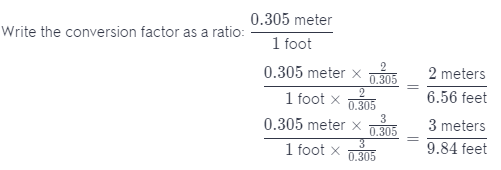
Length ≈ 9.84 feet
Width ≈ 6.56 feet
Find the area.
Area = Length × Width
= 9.84 × 6.56
= 65.55 square feet
Texas Go Math Grade 7 Lesson 3.1 Guided Practice Answer Key
Complete each diagram to solve the problem. (Explore Activity)
Question 1.
Kate ran 5 miles. How far did she run in kilometers?
5 miles = __________________ kilometers
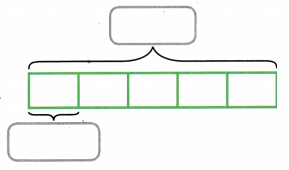
Answer:
First, compete the diagram. Then, with the help of diagram convert units
5 × 1.61 = 8.05
5 miles ≈ 8.05 kilometres
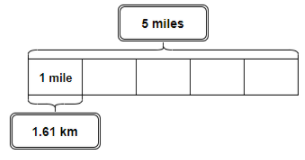
Question 2.
Alex filled a 5-gallon jug with water. How many liters of water are in the container?
5 gallons ≈ _________________ liters

Answer:
First, compete the diagram. Then, with the help of diagram convert units
5 × 3.79 = 18.95
5 gallons ≈ 18.95 liters
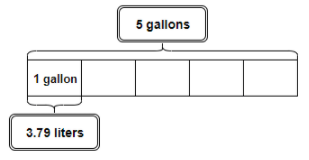
Use a conversion factor to convert each measurement. (Example 1 and 2)
Question 3.
A ruler is 12 inches long. What is the length of this ruler in centimeters?
_________________ centimeters
Answer:
1 in ≈ 2.54 centimeter.

Ruler is 30.48 centimeters long.
Question 4.
A kitten weighs 4 pounds. What is the approximate mass of the kitten?
_________________ kilograms
Answer:
1 pound ≈ 0.454 kilograms
Write the conversion factor as a ratio: \(\frac{0.454 \text { kilograms }}{1 \text { pound }}\)
4 pounds × \(\frac{0.454 \text { kilograms }}{1 \text { pound }}\) ≈ 1.816 kilogram
A kitten weighs 1.816 kilogram.
Use a proportion to convert each measurement. (Example 2)
Question 5.
20 yards ≈ ____________ meters
Answer:
1 yard ≈ 0.914 meter.
Write the conversion factor as a ratio: \(\frac{0.914 \text { meter }}{1 \text { yard }}\)
20 yard × \(\frac{0.914 \text { meter }}{1 \text { yard }}\) ≈ 18.28 meters
Question 6.
12 ounces ≈ ____________ grams
Answer:
1 ounce ≈ 28.4 grams.
Write the conversion factor as a ratio: \(\frac{28.4 \text { grams }}{1 \text { ounce }}\)
12 ounces × \(\frac{28.4 \text { grams }}{1 \text { ounce }}\) ≈ 340.8 meters
Question 7.
5 quarts ≈ ____________ liters
Answer:
1 quart ≈ 0.946 grams.
Write the conversion factor as a ratio: \(\frac{0.946 \text { liter }}{1 \text { quart }}\)
5 quarts × \(\frac{0.946 \text { liter }}{1 \text { quart }}\) ≈ 4.73 liters
Question 8.
400 meters ≈ ____________ yards
Answer:
1 yard ≈ 0.914 meter.
Write the conversion factor as a ratio: \(\frac{1 \text { yard }}{0.914 \text { meter }}\)
400 meters × \(\frac{1 \text { yard }}{0.914 \text { meter }}\) ≈ 437.64 yards
Question 9.
10 liters ≈ ____________ gallons
Answer:
1 gallon ≈ 3.79 liters.
Write the conversion factor as a ratio: \(\frac{1 \text { gallon }}{3.79 \text { liters }}\)
10 liters × \(\frac{1 \text { gallon }}{3.79 \text { liters }}\) ≈ 2.64 gallons
Question 10.
137.25 meters ≈ ____________ feet
Answer:
1 foot ≈ 0.305 meter.
Write the conversion factor as a ratio: \(\frac{1 \text { foot }}{0.305 \text { meter }}\)
137.25 meters × \(\frac{1 \text { foot }}{0.305 \text { meter }}\) ≈ 450 feet
Question 11.
165 centimeters ≈ ___________ inches
Answer:
1 in = 2.54 centimeters.
Write the conversion factor as a ratio: \(\frac{1 \text { in }}{2.54 \text { centimeters }}\)
165 centimeters × \(\frac{1 \text { in }}{2.54 \text { centimeters }}\) = 64.96 inches
Question 12.
10,000 kilometers ≈ ___________ miles
Answer:
1 mile ≈ 1.61 kilometer.
Write the conversion factor as a ratio: \(\frac{1 \text { mile }}{1.61 \text { kilometer }}\)
10,000 kilometers × \(\frac{1 \text { mile }}{1.61 \text { kilometer }}\) ≈ 6211.18 miles
Essential Question Check-In
Question 13.
Write and solve a proportion that can be used to convert 60 inches to centimeters.
Answer:
1 in = 2.54 centimeters.

Texas Go Math Grade 7 Lesson 3.1 Independent Practice Answer Key
Tell which measure is greater.
Question 14.
Six feet or two meters ________________
Answer:
1 foot ≈ 0.305 meter.
Write the conversion factor as a ratio: \(\frac{1 \text { foot }}{0.305 \text { meter }}\)
2 meters × \(\frac{1 \text { foot }}{0.305 \text { meter }}\) ≈ 6.56 feet
6.56 feet > 6 feet
2 meters > 6 feet
Question 15.
One inch or one centimeter ____________
Answer:
1 in = 254 centimeters.
Notice it is obvious that one inch > one centimeter. There is no need for conversion.
Question 16.
One yard or one meter ____________
Answer:
1 yard ≈ 0.9 14 meters.
Notice it is obvious that one meter > one yard. There is no need for conversion.
Question 17.
One mile or one kilometer ______________
Answer:
1 mile ≈ 1.61 kilometer.
Notice it is obvious that one mile > one kilometer. There is no need for conversion.
Question 18.
One ounce or one gram ______________
Answer:
1 ounce ≈ 28.4 grams.
Notice it is obvious that one ounce > one gram. There is no need for conversion.
Question 19.
One quart or one liter _________________
Answer:
1 quart ≈ 0.946 liter.
Notice it is obvious that one liter > one quart. There is no need for conversion.
Question 20.
10 pounds or 10 kilograms ____________
Answer:
1 pound ≈ 0.454 kiLograms.
Notice that it is the same problem as comparing 1 pound to 1 kilogram, it is obvious that one kilogram > one pound There is no need for conversion.
Question 21.
Four liters or one gallon ______________
Answer:
1 gallon ≈ 3.79 liters.
4 liters > 3.79 liters
4 liters > 1 gallon
Question 22.
Two miles or three kilometers ___________
Answer:
1 mile ≈ 1.61 kilometer
Write the conversion factor as a ratio: \(\frac{1 \text { mile }}{1.61 \text { kilometer }}\)
3 kilometer × \(\frac{1 \text { mile }}{1.61 \text { kilometer }}\) ≈ 1.86 miles
2 miles > 1.86 miles
2 miles > 3 kilometers
Question 23.
What is the limit in kilograms?
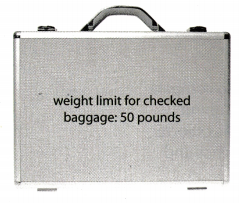
Answer:
1 pound ≈ 0.454 kilogram
Write the conversion factor as a ratio: \(\frac{0.454 \text { kilogram }}{1 \text { pound }}\)
50 pounds × \(\frac{0.454 \text { kilogram }}{1 \text { pound }}\) ≈ 22.7 kilogram
The limit is 22.7 kilograms.
Question 24.
What is the limit in miles per hour?
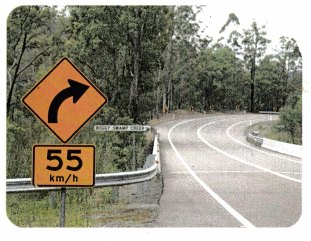
Answer:
1 mile per hour ≈ 1.61 kilometer per hour.
Write the conversion factor as a ratio: \(\frac{1 \text { mile per hour }}{1.61 \text { kilometer per hour }}\)
55 kilometers per hour × \(\frac{1 \text { mile per hour }}{1.61 \text { kilometer per hour }}\) ≈ 34.16 miles per hour
Question 25.
Which container holds more, a half-gallon milk jug or a 2-liter juice bottle?
Answer:
1 gallon ≈ 3.79 liters
Write the conversion factor as a ratio: \(\frac{1 \text { gallon }}{3.79 \text { liters }}\)
2 liters × \(\frac{1 \text { gallon }}{3.79 \text { liters }}\) ≈ 0.53 gallon
0.53 gallon > 0.5 gallon
2 liters > 0.5 gallon
2-liter juice bottle contains more.
Question 26.
The label on a can of lemonade gives the volume as 12 fl oz,, or 355 mL. Verify that these two measurements are nearly equivalent.
Answer:
1 fl oz ≈ 29.6 mL.
Write the conversion factor as a ratio: \(\frac{1 \mathrm{fl} \mathrm{oz}}{29.6 \mathrm{~mL}}\)
355 mL × \(\frac{1 \mathrm{fl} \mathrm{oz}}{29.6 \mathrm{~mL}}\) ≈ 11.99 fl oz
12 fl oz ≈ 11.99 fl oz
Question 27.
The mass of a textbook is about 1.25 kilograms. About how many pounds is this?
Answer:
1 pound ≈ 0.054 kilogram.
Write the conversion factor as a ratio: \(\frac{1 \text { pound }}{0.454 \text { kilogram }}\)
1.25 kilograms × \(\frac{1 \text { pound }}{0.454 \text { kilogram }}\) ≈ 2.75 pounds
The mass of a textbook is about 2.75 pounds.
Question 28.
Critique Reasoning Michael estimated his mass as 8 kilograms. Is his estimate reasonable? Justify your answer.
Answer:
No, his estimate is not reasonable. If he is at the age where he is capable of estimating his own weight in kilograms, then he must be at least 12 years old. Thus, he surely weighs ≥ 35 kilograms.
Question 29.
Your mother bought a three-liter bottle of water. When she got home, she discovered a small leak in the bottom and asked you to find a container to transfer the water into, All you could find were two half-gallon jugs.
a. Will your containers hold all of the water?
Answer:
1 gallon ≈ 3.79 Liters.
Two half gallon = 1 gallon.
3.79 liters> 3 liters
1 gallon > 3 liters
The containers will hold all the water.
b. What If? Suppose an entire liter of water leaked out in the car. In that case, would you be able to fit all of the remaining water into one of the half-gallon jugs? Explain.
Answer:
\(\frac{1}{2}\) gallon = \(\frac{3.79}{2}\) liters
= 1.895 liters
If one liter leaked out that means there is two liters left
2 Liters > 1.895 liters
We would not be able to fit the remaining water into half-gallon jug
Question 30.
The track team ran a mile and a quarter during their practice.
How many kilometers did the team run? ____________________________
Answer:
1 mile ≈ 1.61 kilometer.
Write the conversion factor as a ratio: \(\frac{1.61 \text { kilometer }}{1 \mathrm{mile}}\)
1\(\frac{1}{4}\) mile × \(\frac{1.61 \text { kilometer }}{1 \mathrm{mile}}\) ≈ 2.0125 kilometers
The team ran 2.0125 kilometers.
Question 31.
A countertop is 16 feet long and 3 feet wide.
a. What is the area of the counter top in square meters? ______________ square meters
Answer:
1 foot ≈ 0.305 meter.
Convert both length and width to meters.

Now, calculate the area.
A = length × width
= 4.88 × 0.915
= 4.47 m2
b. Tile costs $28 per square meter. How much will it cost to cover the countertop with new tile? $ ___________________________________
Answer:
Multiply the cost per square meter by the area of the countertop in square meter.
28 × 4.47 = $125.16
Question 32.
At a school picnic, your teacher asks you to mark a field every ten yards so students can play football. The teacher accidentally gave you a meter stick instead of a yard stick. How far apart in meters should you mark the lines if you still want them to be in the right places?
Answer:
1 yard ≈ 0.914 meter.
We have to convert 10 yards to meters.
Write the conversion factor as a ratio: \(\frac{0.914 \text { meter }}{1 \text { yard }}\)
10 yards × \(\frac{0.914 \text { meter }}{1 \text { yard }}\) ≈ 9.14 meters
We should mark the line every 9.14 meters.
Question 33.
You weigh a gallon of 2% milk in science class and learn that it is approximately 8.4 pounds. You pass the milk to the next group, and then realize that your teacher wanted an answer in kilograms, not pounds. Explain how you can adjust your answer without weighing the milk again. Then give the weight in kilograms.
Answer:
1 pound ≈ 0.454 kiLograms.
We have to convert 10 yards to meters.
Write the conversion factor as a ratio: \(\frac{0.454 \text { kilograms }}{1 \text { pound }}\)
8.4 pounds × \(\frac{0.454 \text { kilograms }}{1 \text { pound }}\) ≈ 3.81 kilogram
A gallon of 2% milk weighs 3.81 kilograms.
H.O.T. Focus On Higher Order Thinking
Question 34.
Analyze Relationships Annalisa, Keiko, and Stefan want to compare their heights. Annalisa is 64 inches tall. Stefan tells her, “I’m about 7.5 centimeters taller than you.” Keiko knows she is 1.5 inches shorter than Stefan. Give the heights of all three people in both inches and centimeters to the nearest half unit.
Answer:
First, convert Aniia1in’s height to centimeters to find out how tail Stefan is. Then, convert Stefan’s height to inches to find out how tall Keiko is.
All rounded to the nearest half.
1 in = 2.54 centimeters.

Question 35.
Communicate Mathematical Ideas Mikhael wanted to rewrite the conversion factor” 1 yard 0.914 meter” to create a conversion factor to convert meters to yards. He wrote “1 meter ≈ ___________.” Tell how Mikhael should finish his conversion, and explain how you know.
Answer:
1 yard ≈ 0.914 meter.
Write the conversion factor as a ratio: \(\frac{0.914 \text { meter }}{1 \text { yard }}\)
1 meter × \(\frac{1 \text { yard }}{0.914 \text { meter }}\) ≈ 1.09 yards
We used conversion factor to convert meters to yards, and that is how we know how much 1 meter is in yards.